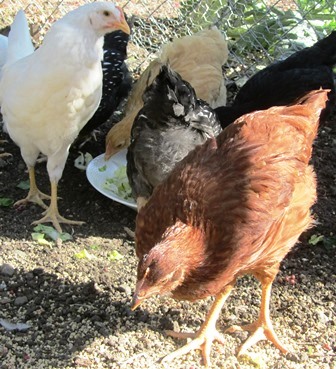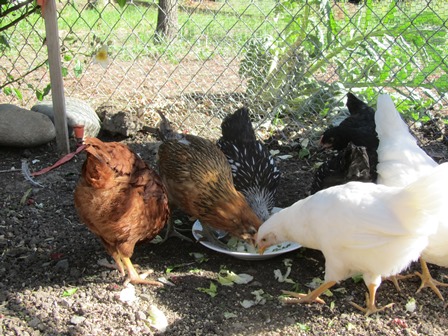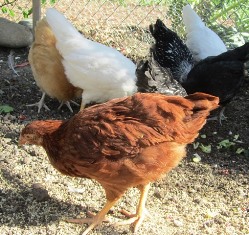Consider This Before You Get Backyard Chickens
My bedroom window faces the back of our property where the chicken coop sits. Every morning, I’m awakened by repeated grauwkkkk sounds made by the Silver Laced Wyandottes and the Rhode Island Red hens, the noisiest ones of all my chickens.
I wish I’d read up more on the breeds before making my selections at the feed store. I love keeping chickens and the eggs are fabulous. That said, there are some of the areas I wish I’d known more about. I might have chosen different breeds.

Rhode Island Red hen seems to be at the top of the pecking order in this small flock of backyard chickens
1. Noisemakers–some breeds are noisier than others. I seldom hear the occasional cluck from my White Leghorns, but the Wyandottes never seem to shut up. Get a bunch of hens together and conversing, and you’ll soon see what I mean.
2. Snacking–chickens love snacks but give them judiciously. If they consume too many treats like blueberries, fresh corn from the cob, and bits of bread or rice, the quality of their eggs may suffer. But as soon as you give them treats, they become your best friends and will follow you around.
3. Pecking–chickens quickly establish a pecking order; they will also peck you . . . some harder and more aggressively than others. My Black Sex Link hen just seems kind of mean and pecks with impatience. But the Rhode Island Red will give an almost loving peck that’s not hard and doesn’t hurt.
4. Broodiness–when a hen goes broody (like my Wyandotte and Buff Orpington hens), her hormones have told her she needs to sit on a clutch of eggs until they hatch (about three weeks). But if you do not have a rooster to have fertilized those eggs, the hen will sit on them anyway, tying up a nesting box and hoarding eggs that will have to be tossed out when she finally figures out that she’s engaged in a futile pursuit of baby chicks. Some breeds tend to broodiness more than others.
5. Water and Food–chickens need water, love crumble, and can benefit from a serving of cracked grains and dried worms. To ensure their egg shells are sufficiently rigid, they may also need additional oyster shell calcium. And like all living beings they need fresh water. If they go without water, they can stop laying for weeks. I’ve figured out the cracked grains must be so tasty they are like cotton candy and after them, the hens don’t want their good food.
6. Diminishing Returns–hens begin laying when they are about five months old. After the first year, egg production will fall off about 20 percent in subsequent years. They generally lay eggs for seven or eight years, but can live to be older and produce no eggs.
7. Egg size–when a hen tries to lay too large of an egg, it can cause a condition called cloaca prolapse. It can claim her life–I’ve lost two chickens to this problem. One was an Ameraucana heritage chicken that laid blue-green eggs. I do miss her as she was skittish but quiet.
8. Moving Hens or a Rooster–if you are getting the gift of a chicken from a neighbor or friend, move that chicken into the flock at night. When he or she wakes up in the morning, the whole event will be a fait accompli and will generate less stress for all involved.
You Can’t Hurry a Chicken into Laying an Egg
I brought home my little flock of baby chicks on March 7. Yesterday marked 16 weeks or four months. That’s important because that’s when the feed store told me I could start expecting eggs from my White Leghorns. Not with mine. They are taking their own sweet time.
The Rhode Island Red can take between 20 and 26 weeks–or so I’ve been told–to start laying. Mine just wants to forage in the yard, follow me around, get in my face, and eat any extra blueberries that I didn’t consume with my morning yogurt and honey. I had a talk with her yesterday about how I’m expecting some eggs in return for all those blueberries.
My flock also includes a Buff Orpington, a Black Sex Link, an Ameraucana, and two Silver Laced Wyandottes, the latter is an old heritage breed can take up to 32 weeks to begin laying. So maybe around Halloween, I’ll find their first offerings.
In anticipation of the big egg-laying event, I’ve switched the chicken food to a crumble for laying hens. Tomorrow I will buy some oyster shell calcium for strong egg shells. I’ve also tucked smooth, wooden eggs into their nesting boxes with some soft straw, hoping to encourage the girls to get with it.
Their voices have now changed from the peep, peep, to cluck, cluck. But I’ve yet to hear that loud cackle that tells me an egg has been laid. Sometimes I’ll see one of some serious squatting and get excited. Okay, this is it. But so far, it isn’t.
So the watch goes on. You can’t hurry a chicken who isn’t ready to produce eggs. So in the meantime, I’ll be eating a lot more yogurt and berries for breakfast.
 Facebook
Facebook Goodreads
Goodreads LinkedIn
LinkedIn Meera Lester
Meera Lester Twitter
Twitter







